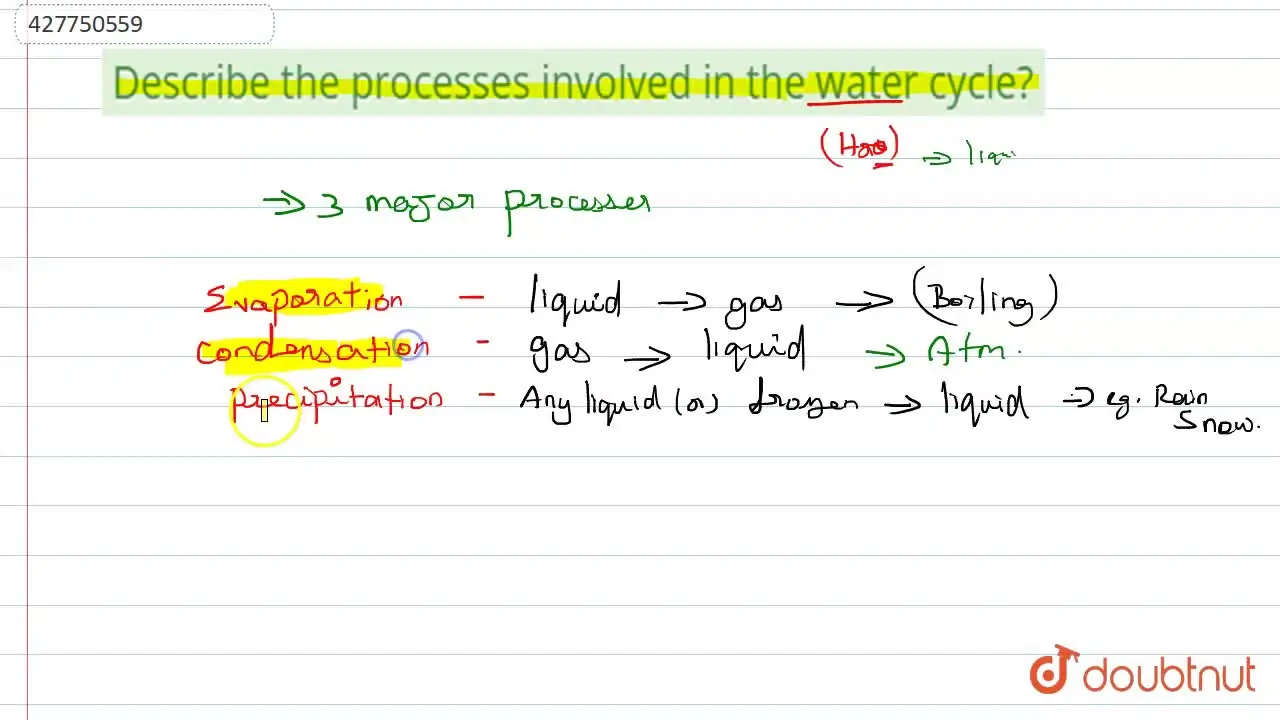Describe the processes involved in the water cycle?Solution in Tamil
Water cycle or hydrological cycle is the continuous movement of water on earth. In this process, water moves from one reservoir to another, from river to ocean or from ocean to the atmosphere by processes such as evaporation, sublimation, transpiration, condensation, precipitation, surface runoff and infiltration, during which water converts itself to various forms like liquid, solid and vapour.
Evaporation: Water evaporates from the surface of the earth and water bodies such as the oceans, seas, lakes, ponds and rivers turn into water vapour.
Sublimation: Ice sheets and ice caps from north and south poles, and icecaps on mountains, get converted into water vapour directly, without converting into liquid.
Transpiration: Transpiration is the process by which plants release water vapour to atmosphere through small pores in leaves and stems.
Condensation: At higher altitudes, the temperature is low. The water vapour present there condenses to form very tiny particles of water droplets. These particles come close together to form clouds and fog.
Precipitation: Due to change in wind or temperature, clouds combine to make bigger droplets, and pour down as precipitation(rain). Precipitation includes drizzle, rain, snow and hail. Run off: As the water pours down, it runs over the surface of earth. Runoff water combines to form channels, rivers, lakes and ends up into seas and oceans.
Infiltration: Some of the precipitated water moves deep into the soil. Then it moves down and increases the ground water level.
Percolation: Some of the precipitated water flows through soil and porous or fractured rock , Infiltration and percolation are two related but different processes describing the movement of water through soil.
Related Playlists
- BOOK - FULL MARKSCHAPTER - ENVIRONMENTAL SCIENCE EXERCISE - EXERCISE (VI. Give reason)3videos
ENVIRONMENTAL SCIENCE
- BOOK - FULL MARKSCHAPTER - ENVIRONMENTAL SCIENCE EXERCISE - ADDITIONAL QUESTIONS (I. Choose the correct answer)10videos
ENVIRONMENTAL SCIENCE
- BOOK - FULL MARKSCHAPTER - ENVIRONMENTAL SCIENCE EXERCISE - EXERCISE (IV. Answer in brief)8videos
ENVIRONMENTAL SCIENCE
- BOOK - FULL MARKSCHAPTER - ECONOMIC BLOLOGYEXERCISE - ADDITIONAL QUESTIONS (ANSWER IN DETAIL )4videos
ECONOMIC BLOLOGY
- BOOK - FULL MARKSCHAPTER - NUTRITION AND HEALTH EXERCISE - ADDITIONAL QUESTIONS (V. Answer the following in detail.)3videos
NUTRITION AND HEALTH
Similar Questions
Roots grow very deep and reach the layers where water is available. Which type of plants develops the above adaptation? Why?
02:10View Solution............. includes plants, animals and all other living organisms.
02:21View SolutionWhat are the two factors of biosphere?
04:05View Solution1. Explain hydroponics and give its importance.
03:02View SolutionWhat is food spoilage? What are the factors responsible for food spoilage ?
04:33View SolutionOne of the following processes is not a step involved in the water cycle operating in nature
02:34View SolutionWhich among the following process is not involved in water cycle?
03:33View Solutionजल चक्र का वर्णन कीजिए |
04:04View SolutionList the processes involved in nitrogen cycle.
05:33View SolutionName two processes involved in cell cycle.
02:46View SolutionOne of the following processes is not a step involved in the water-cycle operation in nature
View SolutionDescribe the events involved in the process of breathing.
View SolutionDescribe the water cycle.
02:24View Solutionअपशिष्ट जल से स्वच्छ जल प्राप्त करने के प्रक्रम में सम्मिलित चरणों का वर्णन करिए।
02:21View Solutionपृथ्वी पर जल-चक्र का वर्णन करें।
02:10View Solution


